Sports' popularity boosted across country, thanks to wider representation at event
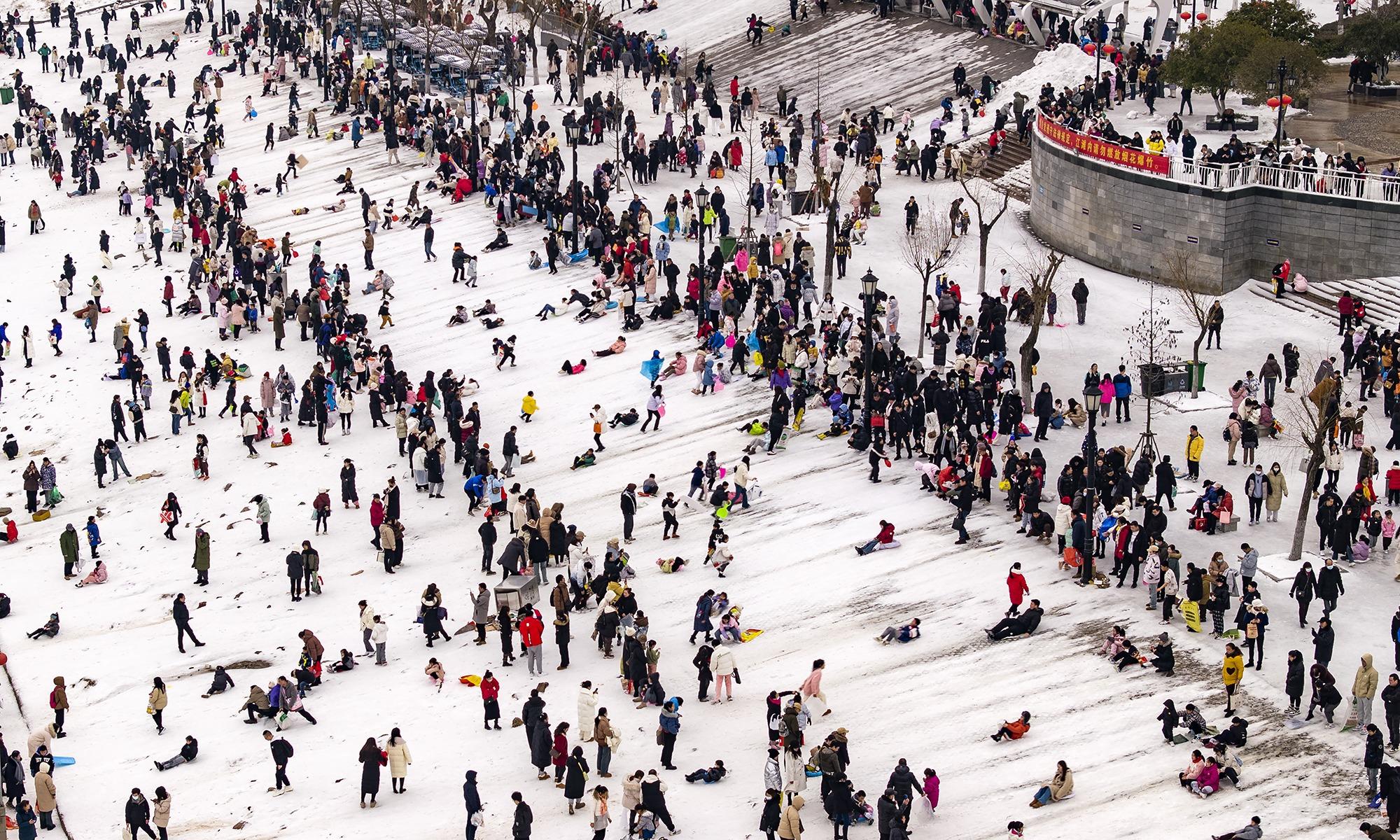 Thousands of people enjoy themselves on the waterfront of the Hanjiang River, a major tributary of the Yangtze River, in Wuhan, the capital of Hubei province, on Feb 24, 2024 after several days of heavy snowfall across the city. (CHEN ZHUO / FOR CHINA DAILY)
Thousands of people enjoy themselves on the waterfront of the Hanjiang River, a major tributary of the Yangtze River, in Wuhan, the capital of Hubei province, on Feb 24, 2024 after several days of heavy snowfall across the city. (CHEN ZHUO / FOR CHINA DAILY)
Taking advantage of the Beijing 2022 Olympics' legacy, the 14th National Winter Games have delivered another huge boost to the popularity and status of winter sports in China.
With thrills and chills over 10 days, China's highest-level winter sports gala capped its largest-ever staging in Hulunbuir, Inner Mongolia autonomous region, on Tuesday to widespread acclaim.
For the first time in its history, the games, which were delayed due to the pandemic, saw a broad representation of the country's demographics. A record number of over 3,700 athletes from 35 delegations, including provinces from the warm southern regions, competed in Hulunbuir and the co-host cities. Since being launched in 1959, the games had only been a "regional "meet of city teams, mostly from the snowy northeastern provinces.
READ MORE: China's National Winter Games closes with a bang
This year, there was also a record 176 medal events after China's sports governing body expanded the program. The expansion was in line with changes to the Olympic format to give Chinese athletes a head start in their preparations for the 2026 Milano Cortina Winter Olympics in Italy.
The larger-than-expected participation, coupled with impressive performances by young athletes whose talents were nurtured in emerging winter sports provinces, has borne witness to the progress of ice and snow sports in China.
The project to boost interest in winter sports was launched before Beijing 2022, with a boom triggered by the home Olympics. The domestic games offered yet another opportunity to keep the momentum going, especially with regional supporters who could cheer on their own athletes.
"Hosting the national games on a bigger scale and involving more athletes — despite being delayed from its original schedule — speaks volumes for the home Olympics' influence on the promotion of winter sports," Zhang Xin, director of athletic competitions at the General Administration of Sport of China, said on Sunday.
"The much-improved performances of athletes hailing from regions such as the central and southern provinces, where skating and skiing used to be only niche choices for sporting activities due to the climate limitations, was particularly encouraging.
"It proves that we are on the right track developing into a more balanced winter sports power and taking advantage of the legacy of Beijing 2022," he said.
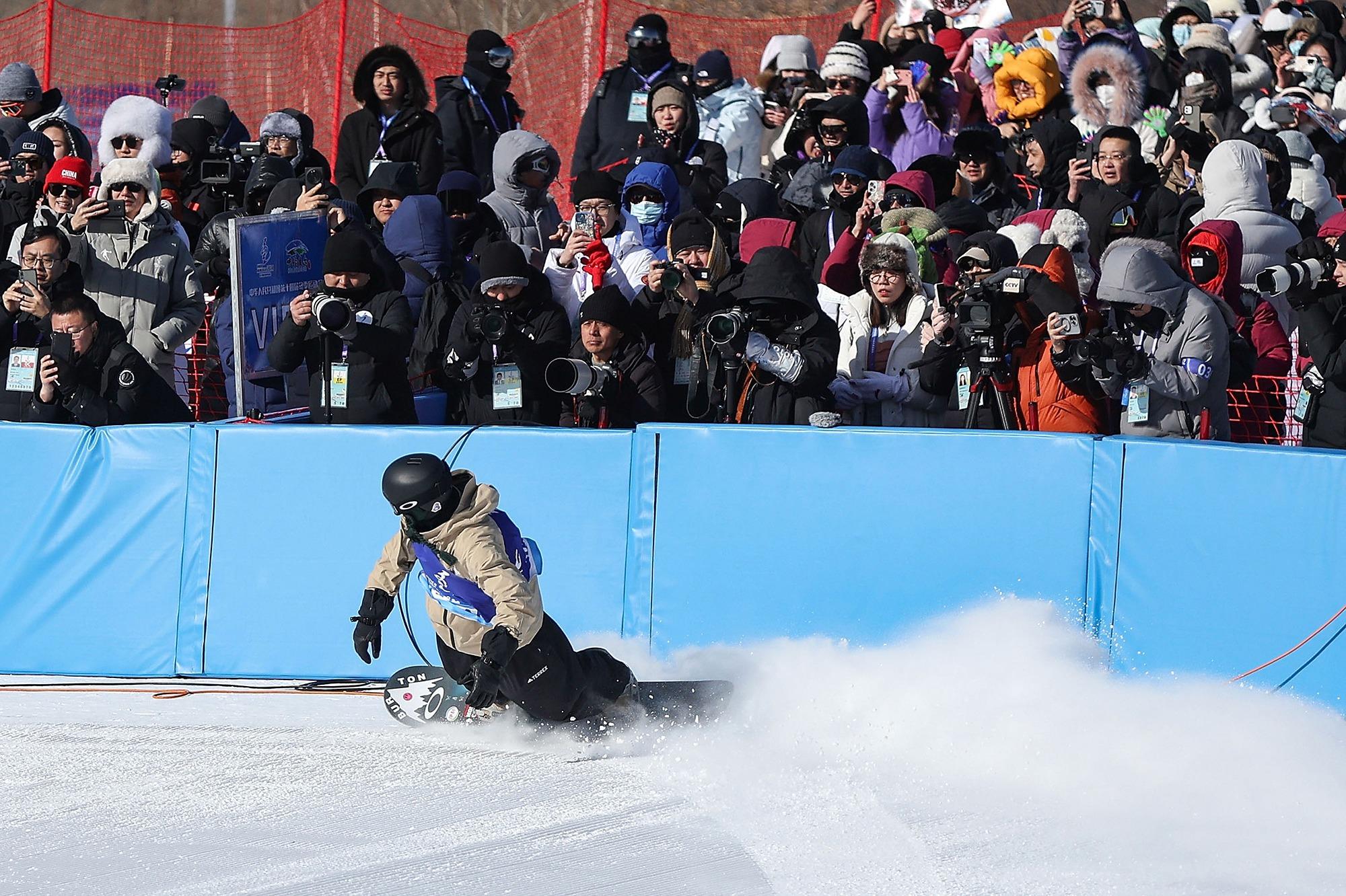 China's reigning Olympic champion Su Yiming and snowboarder Liu Haoyu compete during the recent 14th National Winter Games. (PHOTO / XINHUA)
China's reigning Olympic champion Su Yiming and snowboarder Liu Haoyu compete during the recent 14th National Winter Games. (PHOTO / XINHUA)
True national games
Thirty delegations out of 35 represented in Inner Mongolia won at least one medal, according to official results as of Sunday. The number is up from eight provinces and municipalities that had athletes finish on podiums at the previous national games in 2016.
A joint talent development program, which was designed to combine the financial strength of affluent southern provinces with the training expertise and resources in the country's north, was put in place for the national games and earned credit for leveling the playfield.
Under the program, an athlete was allowed to represent two delegations if coaching, financing and technical support were shared between provincial teams. Each medal won was counted for both delegations involved in the athlete's development.
"Sure, we'd like to encourage everyone to cultivate talent on their own, but the joint program works well for sparking greater interest in less-developed winter sports regions," Zhang said.
"The gap in winter sports knowhow and facilities between the northern and southern regions remains a challenge, but through this reform we are narrowing it to make the national games more competitive."
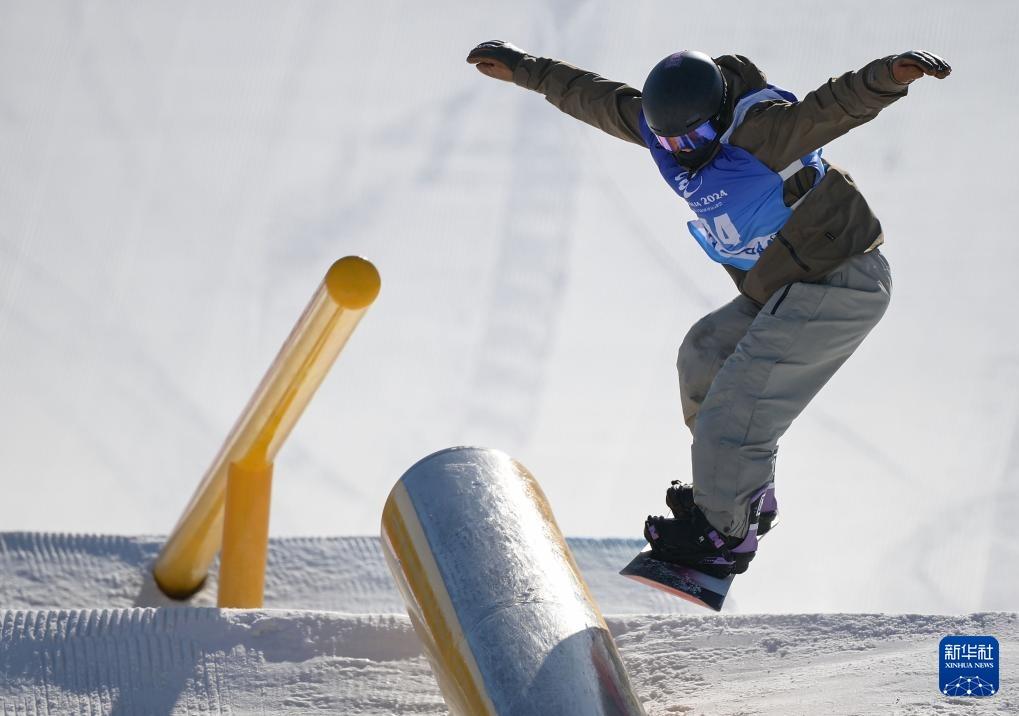 China's reigning Olympic champion Su Yiming and snowboarder Liu Haoyu compete during the recent 14th National Winter Games. (PHOTO / XINHUA)
China's reigning Olympic champion Su Yiming and snowboarder Liu Haoyu compete during the recent 14th National Winter Games. (PHOTO / XINHUA)
China's reigning Olympic champion snowboarder Su Yiming is an example of the success of the joint program. Su represented both Shanxi and Sichuan provinces at the games, winning a pair of gold medals in the Big Air and slopestyle competitions.
"It's been quite healthy competition for all the Chinese snowboarders to go all out against each other and motivate each other at the national games, which helps elevate the level of Chinese snowboarding as a whole," said Su, who became the first Chinese to win an Olympic snowboarding gold medal in the Big Air event at Beijing 2022.
The fact that Su was seriously challenged in Friday's final by runner-up Yang Wenlong from Anhui, an eastern province little known for its winter sports, shows that the gap between the best athletes and the chasing pack is closing fast.
"I am really excited to see so many young athletes express themselves and challenge their senior opponents at the national level. The future of Chinese snowboarding is in good hands," said Su, who turned 20 on Feb 18.
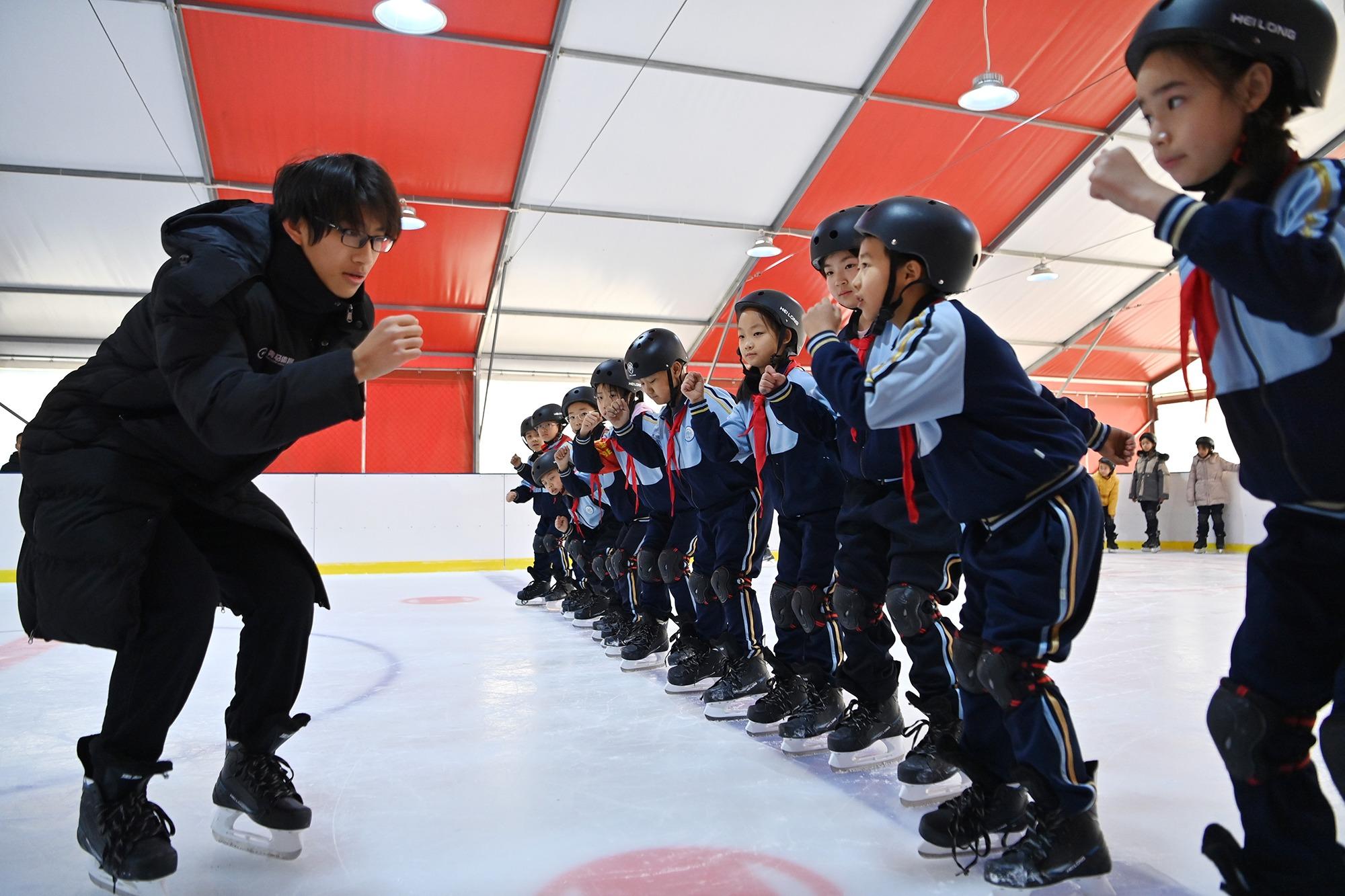 Students take skating lessons on an ice rink at a primary school in Tianjin on Jan 10, 2024. (PHOTO / XINHUA)
Students take skating lessons on an ice rink at a primary school in Tianjin on Jan 10, 2024. (PHOTO / XINHUA)
Green, sustainable
Promoted as a "green, sustainable and shared" event, the winter nationals maximized the use of existing facilities, such as the National Sliding Center in Beijing's Yanqing district and the National Ski Jumping Center in Zhangjiakou, Hebei province, which co-hosted the 2022 Games.
The reuse of Olympic venues prevented unnecessary investment in highly technical and costly construction, while guaranteeing venues for national competitions were up to Olympic standards.
A venue for bobsled, skeleton and luge events, the Yanqing sliding center has been busy since the Olympics. In November, the 1.9-kilometer track hosted an International Bobsled and Skeleton Federation World Cup race.
Training facilities and performance analysis methods developed for the Beijing Olympics also benefited athletes' preparations for the national games.
Wang Zhiyu and Zhu Zeyangxu, who represented East China's Fujian province and were surprise runners-up in the mixed doubles curling, owed a lot to Beijing 2022's "ripple effect", said their coach Li Hongbo.
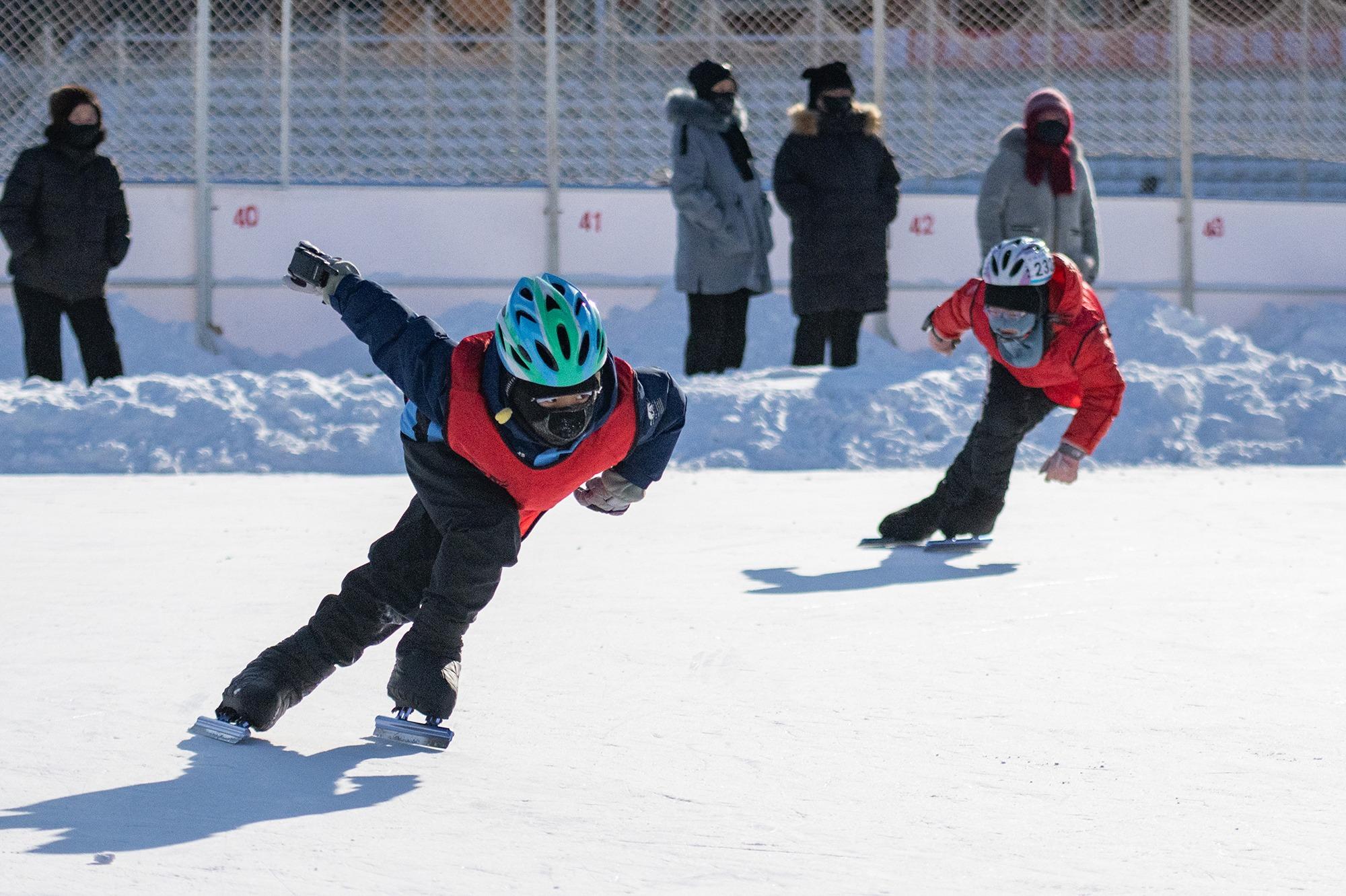 Children skate on the ice rink at the Heihe Fitness Center in Heilongjiang province on Jan 31, 2024. (PHOTO / XINHUA)
Children skate on the ice rink at the Heihe Fitness Center in Heilongjiang province on Jan 31, 2024. (PHOTO / XINHUA)
"We never expected we would end up on the podium at our curling debut at the National Winter Games," Li, a former curler, said. It was the first medal Fujian had ever won at the games after the team's narrow 7-6 defeat by a more experienced pair from Heilongjiang province.
Li said following Beijing 2022, curling, an indoor winter sport unaffected by weather conditions, has gained traction in Fujian. "Our athletes now have more competition opportunities and the sport has drawn more fans in the province," Li said, adding his charges learned from reviewing competition videos and postgame analyses. "This strategy quickly builds experience and trains our athletes," Li said.
Derek Livingston, the Canadian coach of China's star snowboarder Liu Jiayu, applauded the rapid development of skiing facilities in China since Beijing 2022.
"In Canada, we have only one world-class halfpipe. However, in China I've encountered at least three world-class halfpipes, with another one under construction for the national team. It's impressive to see the level of support and resources China offers to its athletes," said the 33-year-old former pro who helped Liu win the silver medal in the women's halfpipe competition in Hulunbuir.
Thirty volunteers who worked at Beijing 2022 also attended the Winter Games to help organizers ensure events were run to Olympic standards.
"To serve as a volunteer at a major sporting event again brought back all my fond memories of the Beijing Winter Olympics. I really appreciate this second chance," said Qin Jiaxin, a graduate student from Beijing Normal University, who left his family on the third day of the Chinese New Year holiday to travel to Hulunbuir.
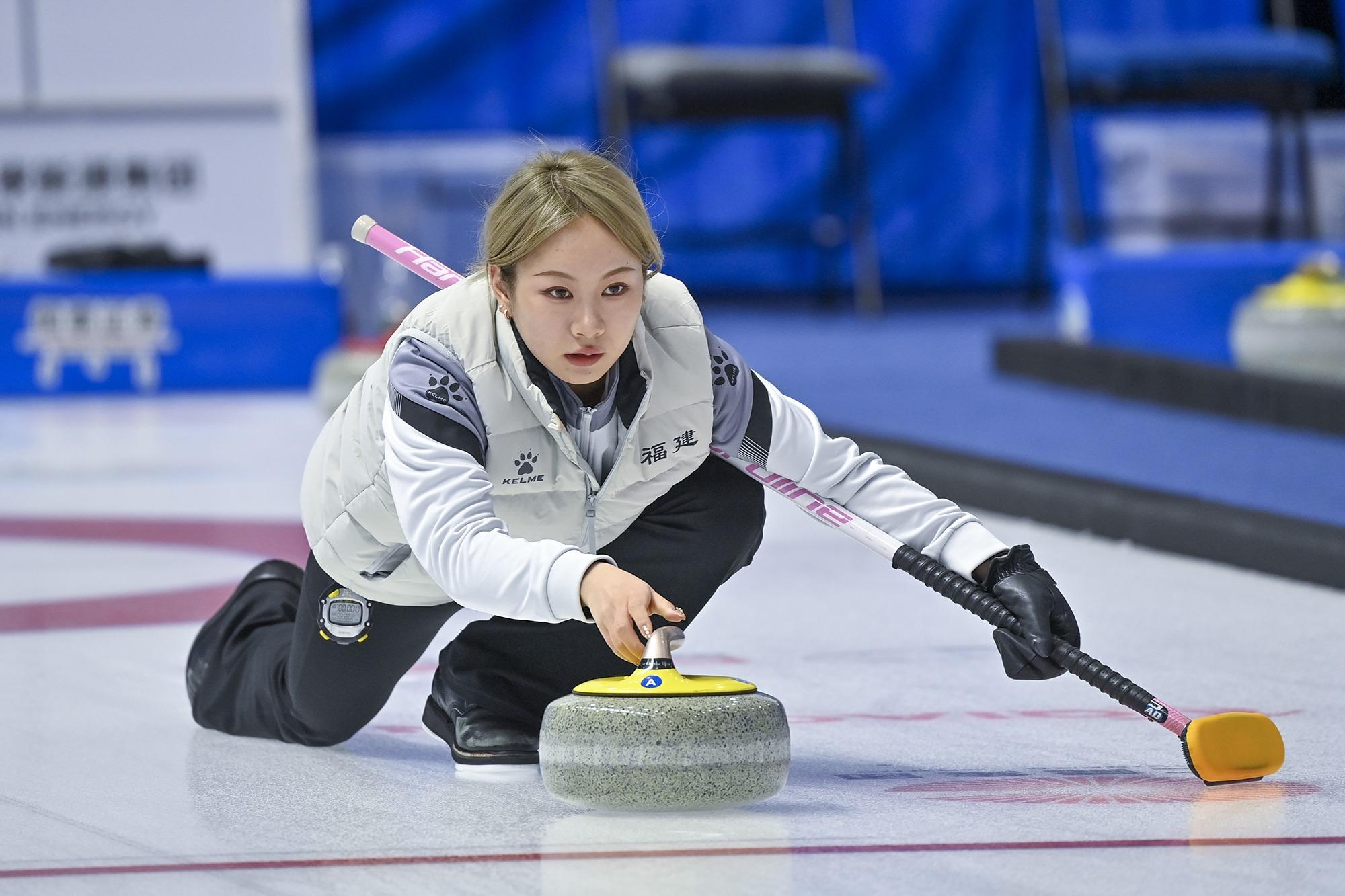 Curler Zhu Zeyangxu, who represented Fujian province, competes during the recent National Winter Games. (PHOTO / XINHUA)
Curler Zhu Zeyangxu, who represented Fujian province, competes during the recent National Winter Games. (PHOTO / XINHUA)
Jobs, tourism boom
Similar to the Beijing 2022 Olympics, which ran from Feb 4 to 20, the 14th National Winter Games saw the majority of its competitions overlap with the Spring Festival holiday. This overlap spurred an even bigger tourism boom around winter sports and related leisure activities than two years ago, when pandemic control measures were in place.
Traditionally, Chinese prefer to spend their Spring Festival holidays in warmer southern destinations, such as Hainan province. However, the attraction of ice and snow activities, promoted by the National Winter Games, proved a "game-changer" this year.
Hulunbuir received a record number of 1.66 million visits during the eight-day Spring Festival holiday, nine times the total in 2023. Tourism revenue increased tenfold from the previous year to 1.14 billion yuan ($160 million), according to the city government.
"Hosting the National Winter Games offered us a great opportunity to promote our ice and snow tourism attractions," Sun Hui, a deputy mayor of Hulunbuir, said at a news conference on Feb 16, a day before the opening ceremony.
Inspired by star athletes such as Olympic freestyle skiing champion Gu Ailing and snowboarding prodigy Su, more and more people are taking up winter sports in cities with warmer climates that rarely see snow.
In Southwest China's Chongqing, a passion for winter sports has gripped the city. Known better for its scorching summers, it has been transformed into a hub for ice and snow activities thanks to the development of indoor facilities.
Chongqing, which sent a team to the National Winter Games for the first time, has seen surging public demand at nine skating rinks and 10 ski venues, including two indoor ones, this winter.
Ma Fuqiang, a ski instructor at Jinfo Mountain Ski Resort who hails from Heilongjiang, has noticed the growing interest in winter sports. "Most tourists at the ski resort are beginners. They get very excited when they see snow, which drives a high demand for ski instructors," Ma said.
At Jinfo Mountain resort there are more than 140 ski instructors, most of whom come from Northeast China and work from mid-November to early March. During periods of strong demand on weekends or holidays, the resort sometimes experiences a shortage of instructors.
ALSO READ: Winter sports in China eye white-hot growth
The demand will only grow stronger, said Wu Yannian, a professor from the School of Physical Education at Jinan University in Guangzhou, Guangdong province.
"The majority of ski resort visitors in the south are still winter sports beginners. The progression in their skill levels will result in higher demand for services and facilities, helping tap into greater market potential," he said of winter sports participation in South China.
The newfound passion of ordinary Chinese for winter sports has also impressed international officials, such as Sarah Henderson from the United Kingdom, the short-track speedskating chief referee at the Hulunbuir games.
"There is everything we need for a competition. It is a great event for the athletes and coaches with the fantastic ice rink and facilities here," Henderson told Xinhua.
After witnessing an exceptionally successful competition at Beijing 2022, Henderson said she was again in awe of the Chinese crowd's enthusiasm for winter sports.
"They love skaters. I saw the posters of Wu Dajing (Olympic champion skater). It is an enjoyable environment," said Henderson, who has visited China four times since her first trip to Beijing for an Olympic test event in 2021.
"I really enjoy seeing the promotion of winter sports. There are many young talents in China. Keep going. It will be exciting."


